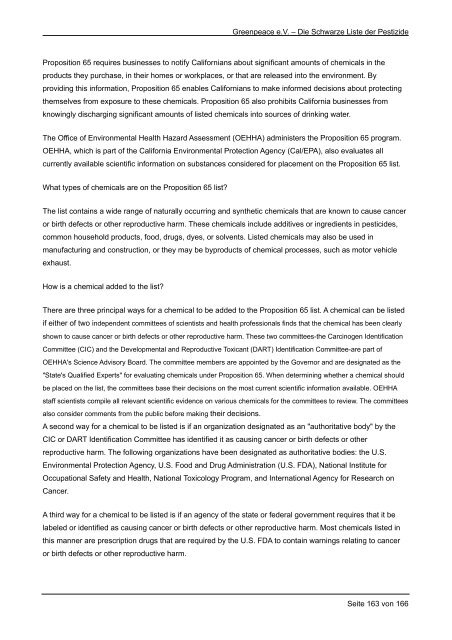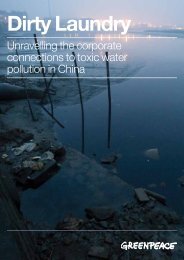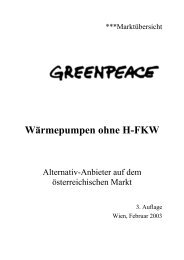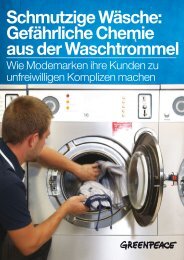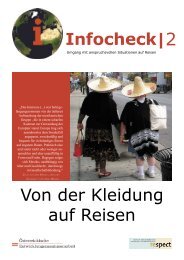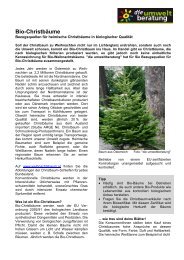Die Schwarze Liste der Pestizide - Greenpeace
Die Schwarze Liste der Pestizide - Greenpeace
Die Schwarze Liste der Pestizide - Greenpeace
Sie wollen auch ein ePaper? Erhöhen Sie die Reichweite Ihrer Titel.
YUMPU macht aus Druck-PDFs automatisch weboptimierte ePaper, die Google liebt.
<strong>Greenpeace</strong> e.V. – <strong>Die</strong> <strong>Schwarze</strong> <strong>Liste</strong> <strong>der</strong> <strong>Pestizide</strong><br />
Proposition 65 requires businesses to notify Californians about significant amounts of chemicals in the<br />
products they purchase, in their homes or workplaces, or that are released into the environment. By<br />
providing this information, Proposition 65 enables Californians to make informed decisions about protecting<br />
themselves from exposure to these chemicals. Proposition 65 also prohibits California businesses from<br />
knowingly discharging significant amounts of listed chemicals into sources of drinking water.<br />
The Office of Environmental Health Hazard Assessment (OEHHA) administers the Proposition 65 program.<br />
OEHHA, which is part of the California Environmental Protection Agency (Cal/EPA), also evaluates all<br />
currently available scientific information on substances consi<strong>der</strong>ed for placement on the Proposition 65 list.<br />
What types of chemicals are on the Proposition 65 list?<br />
The list contains a wide range of naturally occurring and synthetic chemicals that are known to cause cancer<br />
or birth defects or other reproductive harm. These chemicals include additives or ingredients in pesticides,<br />
common household products, food, drugs, dyes, or solvents. <strong>Liste</strong>d chemicals may also be used in<br />
manufacturing and construction, or they may be byproducts of chemical processes, such as motor vehicle<br />
exhaust.<br />
How is a chemical added to the list?<br />
There are three principal ways for a chemical to be added to the Proposition 65 list. A chemical can be listed<br />
if either of two independent committees of scientists and health professionals finds that the chemical has been clearly<br />
shown to cause cancer or birth defects or other reproductive harm. These two committees-the Carcinogen Identification<br />
Committee (CIC) and the Developmental and Reproductive Toxicant (DART) Identification Committee-are part of<br />
OEHHA's Science Advisory Board. The committee members are appointed by the Governor and are designated as the<br />
"State's Qualified Experts" for evaluating chemicals un<strong>der</strong> Proposition 65. When determining whether a chemical should<br />
be placed on the list, the committees base their decisions on the most current scientific information available. OEHHA<br />
staff scientists compile all relevant scientific evidence on various chemicals for the committees to review. The committees<br />
also consi<strong>der</strong> comments from the public before making their decisions.<br />
A second way for a chemical to be listed is if an organization designated as an "authoritative body" by the<br />
CIC or DART Identification Committee has identified it as causing cancer or birth defects or other<br />
reproductive harm. The following organizations have been designated as authoritative bodies: the U.S.<br />
Environmental Protection Agency, U.S. Food and Drug Administration (U.S. FDA), National Institute for<br />
Occupational Safety and Health, National Toxicology Program, and International Agency for Research on<br />
Cancer.<br />
A third way for a chemical to be listed is if an agency of the state or fe<strong>der</strong>al government requires that it be<br />
labeled or identified as causing cancer or birth defects or other reproductive harm. Most chemicals listed in<br />
this manner are prescription drugs that are required by the U.S. FDA to contain warnings relating to cancer<br />
or birth defects or other reproductive harm.<br />
Seite 163 von 166


